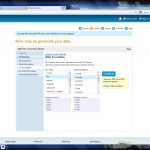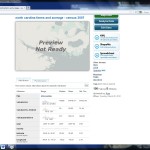Analyze, discover, manage, map, and visualize your data with Duke Libraries Data and GIS Services. Our team of five consultants provides a broad range of support in areas ranging from data analysis, data visualization, geographic information systems, financial data, statistical software and data storage and management. Our lab provides 12 workstations with the latest data software and three Bloomberg Professional workstations nearly 24/7 for the Duke community.
Data and GIS Workshop Series
All are welcome to the Data and GIS Workshop Series. Analyze, communicate, clean, map, represent and visualize your data with a wide range of workshops on data based research methods and tools. Details and registration for each class are available at the links that follow. (Interested in keeping up to date with workshops and events in Data and GIS? Just go to https://lists.duke.edu/sympa/info/dgs-announce and click on the “Subscribe” link at the bottom left.)
Tue, Sep 3, 2013 1:00 PM - 3:00 PM Introduction to ArcGIS Wed, Sep 4, 2013 10:00 AM - 11:30 AM Stata for Research Wed, Sep 11, 2013 10:00 AM - 11:00 AM Open (aka Google) Refine Thu, Sep 12, 2013 1:00 PM - 3:00 PM Analysis with R Tue, Sep 17, 2013 1:00 PM - 2:30 PM Introduction to Tableau Public 8 Thu, Sep 19, 2013 10:00 AM - 11:00 AM Google Fusion Tables Mon, Sep 23, 2013 1:00 PM - 2:30 PM Introduction to Tableau Public 8 Tue, Sep 24, 2013 1:00 PM - 2:30 PM Stata for Research Mon, Sep 30, 2013 10:00 AM - 11:00 AM Top 10 Dos and Don'ts for Charts and Graphs Mon, Sep 30, 2013 1:00 PM - 3:00 PM Introduction to ArcGIS Tue, Oct 8, 2013 1:00 PM - 2:30 PM Introduction to Text Analysis Thu, Oct 10, 2013 1:00 PM - 3:00 PM ArcGIS Special Topics: Geocoding & Proximity Analysis Thu, Oct 17, 2013 1:00 PM - 3:00 PM Historical GIS Mon, Oct 28, 2013 1:00 PM - 2:00 PM Designing Academic Figures and Posters Tue, Oct 29, 2013 1:00 PM - 3:00 PM Web GIS Applications
Data and GIS also offers instruction tailored to courses or research teams. Please contact askdata@duke.edu to schedule a session!
Data Management
Data Management Planning – DMPTool – Get 24/7 online help for your next data management plan, including information about Duke resources available for your data work.
Statistical Software Updates
- Stata 13 is now available in our lab and training room
- QSR’s Nvivo qualitative software is available on all machines
- 3 Bloomberg Professional Workstationsare available for individual or group use
Explore all of our Data and GIS Lab resources on our site at http://library.duke.edu/data/about/lab.html or come visit us on the second floor of Perkins Library.
Job Opportunities in Data and GIS Services
Data & GIS Services is hiring! We have two open positions for student web programmers interested in working on data visualization projects. See the Library Student employment page (http://library.duke.edu/jobs/students.html) for more information on how to apply. (The job can be found by searching for requisition number “DUL14-AMZ02”.)
New Data and Map Collections
CPS on Web (CPS Utilities Online)
CPS on Web is a set of utilities enabling you to access CPS data and documentation from this website. You may make tables and graphs from the CPS data, download data extractions, make estimations, get summaries and statistical measures, search the documentation, and make your own variables as functions of the existing ones.
Global Financial Data
Global Financial Data is a collection of financial and economic data provided in ASCII or Excel format. Data includes: long-term historical indices on stock markets; Total Return data on stocks, bonds, and bills; interest rates; exchange rates; inflation rates; bond indices; commodity indices and prices; consumer price indices; gross domestic product; individual stocks; sector indices; treasury bill yields; wholesale price indices; and unemployment rates covering over 200 countries.
LandScan Global
The LandScan Global Population Database provides global population distribution in a gridded GIS format at 30 arc-second resolution (approximately 1×1 km cells). Oak Ridge National Laboratory developed modeling techniques to disaggregate and interpolate census data within administrative boundaries to create a GIS layer showing population distribution as accurately and as timely as possible. EastView provides this data to use in GIS software as a WMS (Web Mapping Service) or as a WCS (Web Coverage Service) to allow a user to incorporate population distribution into GIS mapping and analysis.
Contact Us
email: askdata@duke.edu
twitter: duke_data or duke_vis









